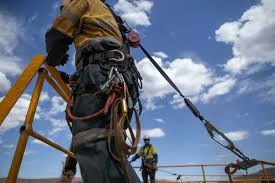


 349,500 Offered Certificates
349,500 Offered Certificates
 24/7 Online Training
24/7 Online Training
 Money Back Guarantee
Money Back Guarantee
 Fully Accredited Courses
Fully Accredited Courses

Created at: 22-02-2025 17:11
Working at heights is a hazardous undertaking, yet it is a vital part of many industries. Whether it's construction, maintenance, or any other work that requires elevation, ensuring the safety of those involved is paramount. This guide will cover the essential safety gear required for working at heights, the significance of each piece of equipment, how to use it correctly, and maintenance best practices.
Fall accidents are among the leading causes of workplace injuries and fatalities. Therefore, investing in the right safety gear is not just a regulatory requirement but a fundamental practice to protect workers' lives.
Safety harnesses are a critical component of fall protection. They distribute the force of a fall across the body, minimizing the risk of injury.
Lanyards are connected to the safety harness and anchorage points to secure workers.
Anchor points are secure structures that support fall protection systems.
Helmets protect workers from falling objects and impacts.
When working at heights, gloves offer grip and protect against environmental hazards.
These systems are designed to prevent injuries during a fall.
Compliance with safety regulations is mandatory. In many countries, rules specify the requirement of safety gear for working at heights. Understanding these regulations is crucial for ensuring both compliance and safety. In Ireland, for example, regulations dictate that employers must provide appropriate fall protection systems as detailed in the Safety, Health and Welfare at Work Regulations.
Using safety gear correctly is just as important as having the right tools. Here are some best practices:
Correct maintenance helps extend the lifespan of your safety equipment:
The safety of employees working at heights cannot be overstated. Investing in certified safety gear and comprehensive Working at Heights training is essential for ensuring safety and compliance.
Ensure you are equipped and trained by enrolling in a Working at Heights Course Online today! For further inquiries, feel free to reach out at [email protected].